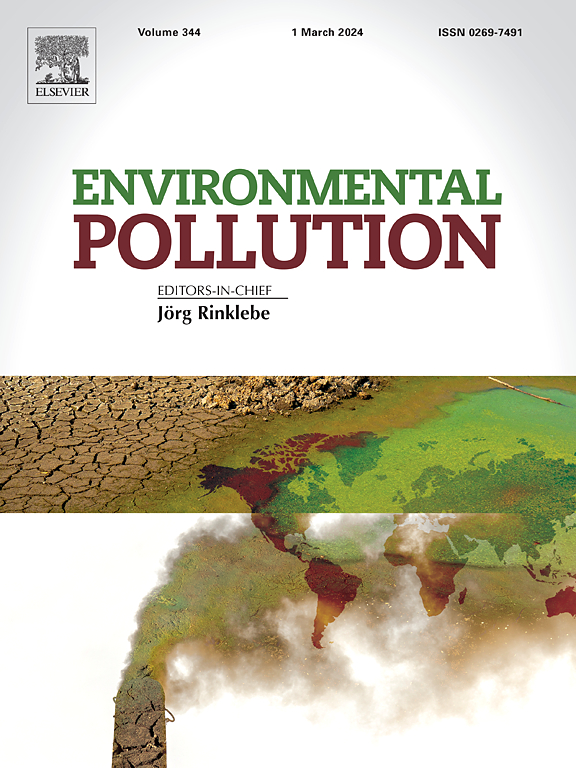Comparative evaluation of biodegradable microplastic presence in edible and non-edible tissues of cage-cultured and wild fishes of Periyar River
IF 7.6
2区 环境科学与生态学
Q1 ENVIRONMENTAL SCIENCES
引用次数: 0
Abstract
Biodegradable plastics (BPs) are considered a promising alternative to conventional plastics; however, their biodegradation necessitates specific conditions and can persist in the environment for extended periods, posing toxicological effects on aquatic ecosystems and their organisms similar to conventional microplastics. The studies on biodegradable microplastics (BMPs) are limited and therefore, this study, aimed to evaluate the BMP presence in the gastrointestinal tract (GIT) and edible tissues of wild-caught and cage-cultured fishes of Periyar River, Kerala, India. Etroplus suratensis (n=300) and Oreochromis mossambicus (n=300) were collected from both sources. The study found BMPs in the GIT of all fishes sourced from cages and wild, with a higher but statistically insignificant abundance in wild fishes: 0.06±0.26 items/individual (0.01±0.00 items/g) in E. suratensis and 0.03±0.23 items/individual (0.01±0.01 items/g) in O. mossambicus. No BMPs were found in the edible tissues of cage-cultured fish, but they were detected in wild-caught fishes, i.e., 0.02 0.13 items/individual (0.02 0.01 items/g) in E. suratensis and 0.01 0.11 items/individual (0.02 0.01 items/g) in O. mossambicus. Poly (butylene adipate-co-terephthalate) (PBAT) and polylactic acid (PLA) were the only BMPs obtained in fish from both sources with the former being the dominant one. The potential annual average human exposure risk from the wild-caught fish was estimated from both fish species and the findings suggest children have a higher risk of exposure, i.e., 551 items/year followed by adults, i.e., 394 items/year and aged individuals, i.e., 239 items/year. The documented harmful impacts of BMPs on aquatic organisms, combined with the findings of this study, suggest the need for a thorough reassessment of BP production and disposal practices. Additionally, implementing robust monitoring systems is essential to food safety and public health.

生物降解塑料(BPs)被认为是替代传统塑料的一种前景广阔的材料;然而,它们的生物降解需要特定的条件,而且会在环境中长期存在,对水生生态系统及其生物造成与传统微塑料类似的毒理学影响。有关生物可降解微塑料(BMPs)的研究十分有限,因此本研究旨在评估印度喀拉拉邦佩里亚尔河野生捕捞鱼类和网箱养殖鱼类胃肠道(GIT)和食用组织中的 BMP 存在情况。研究人员从这两种来源收集了苏拉特鱼(Etroplus suratensis,n=300)和莫桑比克裸颊鱼(Oreochromis mossambicus,n=300)。研究在所有网箱和野生鱼类的胃肠道中都发现了 BMPs,其中野生鱼类的 BMPs 丰度较高,但在统计学上并不显著:E. suratensis 为 0.06±0.26 个/个体(0.01±0.00 个/克),O. mossambicus 为 0.03±0.23 个/个体(0.01±0.01 个/克)。在网箱养殖鱼类的可食用组织中未发现 BMPs,但在野生捕捞的鱼类中检测到了 BMPs,即在 E. suratensis 中为 0.02 0.13 项/个体(0.02 0.01 项/克),在 O. mossambicus 中为 0.01 0.11 项/个体(0.02 0.01 项/克)。聚对苯二甲酸丁二醇酯(PBAT)和聚乳酸(PLA)是这两种来源的鱼类中唯一的生物放大剂,前者是主要的生物放大剂。结果表明,儿童的暴露风险较高,为 551 项/年,其次是成人,为 394 项/年,再次是老年人,为 239 项/年。BMP 对水生生物的有害影响已有文献记载,结合本研究的结果,表明有必要对 BP 的生产和处置方法进行彻底的重新评估。此外,实施强有力的监测系统对食品安全和公众健康至关重要。
本文章由计算机程序翻译,如有差异,请以英文原文为准。
求助全文
约1分钟内获得全文
求助全文
来源期刊

Environmental Pollution
环境科学-环境科学
CiteScore
16.00
自引率
6.70%
发文量
2082
审稿时长
2.9 months
期刊介绍:
Environmental Pollution is an international peer-reviewed journal that publishes high-quality research papers and review articles covering all aspects of environmental pollution and its impacts on ecosystems and human health.
Subject areas include, but are not limited to:
• Sources and occurrences of pollutants that are clearly defined and measured in environmental compartments, food and food-related items, and human bodies;
• Interlinks between contaminant exposure and biological, ecological, and human health effects, including those of climate change;
• Contaminants of emerging concerns (including but not limited to antibiotic resistant microorganisms or genes, microplastics/nanoplastics, electronic wastes, light, and noise) and/or their biological, ecological, or human health effects;
• Laboratory and field studies on the remediation/mitigation of environmental pollution via new techniques and with clear links to biological, ecological, or human health effects;
• Modeling of pollution processes, patterns, or trends that is of clear environmental and/or human health interest;
• New techniques that measure and examine environmental occurrences, transport, behavior, and effects of pollutants within the environment or the laboratory, provided that they can be clearly used to address problems within regional or global environmental compartments.
 求助内容:
求助内容: 应助结果提醒方式:
应助结果提醒方式:


